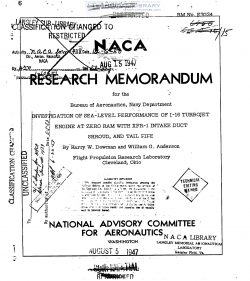naca-rm-e7g24
- Version
- 62 Downloads
- 1.69 MB File Size
- 1 File Count
- April 21, 2017 Create Date
- April 21, 2017 Last Updated
National Advisory Committee for Aeronautics, Research Memorandum - Investigation of Sea-Level Performance of I-16 Turbojet Engine at Zero Ram with XFR-1 Intake Duct Shroud, and Tail Pipe

The sea—level performance of an I—lS turbojet engine at zero
ram was investigated to determine the effects of an intake duct, a-
shroud, and a tail pipe intended for installation in an XFR-l air—
plane. The investigation.was conducted over a range_of engine speeds
frem 8000 to 16,500 rpm for several arrangements of the intake duct '
and tail pipes: the XER-l duct, shroud, and tail pipe with the
boundary-layer slot closed and open and with boundaryLlayer removal
by suction; the KER-l duct with a tail pipe frdm a P459A airplane
and boundarywlayer removal; and with no intake duct or shroud with
both the P—59A and the KER-l tail pipes. The data were corrected to
standard atmospheric conditions and then adjusted to a commbn exhaust-
gas temperature.
The maximum.total-pressure loss in the intake duct and shroud
of 3.36 percent of the ambient pressure, occurred with the boundary—
1ayer slot open at a corrected rotor speed sf 16,500 rpm. The ‘
attendant loss in thrust was 90 pounds. The intake-duct total-
pressure losses for the other three configurations with the duct
were between 2.64 and 2.70 percent of the ambient pressure with
accompanying thrust losses of 80 to 86 pounds at the same engine
rotor speed. The maximum thrust loss caused by the KER-l tail pipe,
as compared with the P-59A tail pipe, was 24 pounds at a corrected
rotor speed of 15,000 rpm. At maximum corrected rotor speed
(16,500 rpm) the thrust loss caused by the XFR- l tail pipe was
13 pOunds.
At the request of the Bureau of Aeronautics, navy Department,
an investigation has been conducted to determine the effects of an
intake duct, shroud, and tail pipe, intended for installation in
the XFR—l airplane, on the sea-level performance of an I-16 turbodet
engine at zero ram over a range of engine speeds from 8000 to
16,500 rpm.
| File | Action |
|---|---|
| naca-rm-e7g24 Investigation of Sea-Level Performance of I-16 Turbojet Engine at Zero Ram with XFR-1 Intake Duct Shroud,.pdf | Download |

Comment On This Post